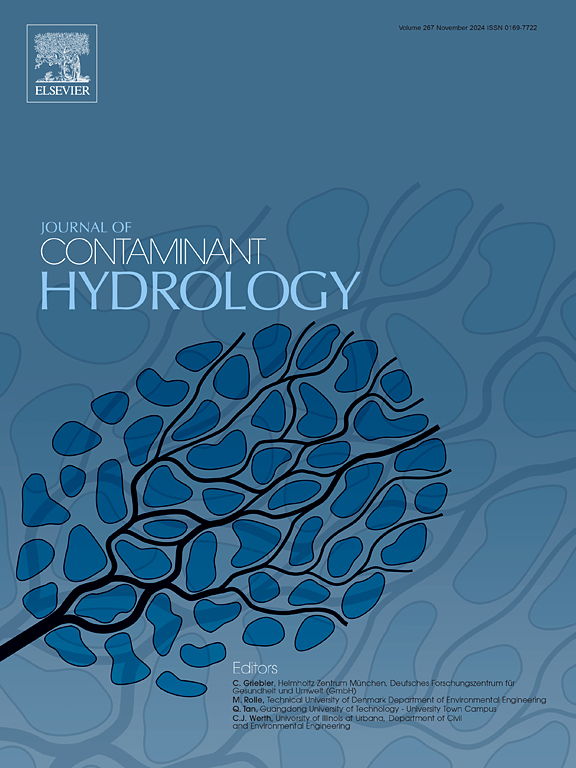Identification of heavy metal sources in reservoir-adjacent soils and specific source risk assessment based on comprehensive environmental factors: A perspective on prioritizing control sources
IF 4.4
3区 环境科学与生态学
Q2 ENVIRONMENTAL SCIENCES
引用次数: 0
Abstract
Heavy metal (HM) contamination in reservoir-adjacent soils is influenced by complex environmental factors and poses ecological and health risks. This study analyzed eight HMs (As, Cd, Cr, Cu, Hg, Ni, Pb, Zn) in 181 soil samples from Zhijin County, China, with mean concentrations exceeding regional background values by 1.06 to 7.00 times (except As, which was 91.4 % of the Guizhou background value). This study aimed to identify HM sources and associated risks by integrating GeoDetector (GD) and Positive Matrix Factorization (PMF) models in Zhijin County, China. The GD analysis revealed that river proximity (q = 0.544) had the strongest explanatory power for Cd spatial variation, while soil organic matter (q = 0.281) had the greatest influence on Pb distribution. The PMF identified five sources with quantified contributions and their dominant associated metals: a mining–agricultural mix (28.16 %; mainly Cd, Cu, Ni, and Zn), atmospheric deposition (20.39 %; mainly Hg), soil parent material (19.86 %; mainly Cr and Ni), agricultural activities (16.98 %; mainly As), and a transportation–mining mix (14.61 %; mainly Pb). Risk prioritization showed that mining and agricultural sources contributed 38.7 % of the ecological risk, while agricultural activities accounted for 41.2 % of children's non-carcinogenic risk, with ingestion contributing 89.7 % of non-carcinogenic exposure. The integrated GD-PMF framework improved the source resolution accuracy by 22–35 % compared to conventional methods. These results offer a novel source-oriented framework for prioritizing the control of Cd and Hg, which exhibited the highest ecological and health risks. Meanwhile, the framework also provides scientific support for the differentiated management of other heavy metals such as Pb and As, based on their source characteristics and spatial patterns.
基于综合环境因素的库邻土壤重金属源识别及特定源风险评价——基于优先控制源的视角
水库周边土壤重金属污染受复杂环境因素影响,具有生态和健康风险。本文分析了织金县181份土壤样品中的8种重金属(As、Cd、Cr、Cu、Hg、Ni、Pb、Zn),平均浓度超出区域背景值1.06 ~ 7.00倍(As为贵州背景值的91.4%)。本研究旨在通过整合GeoDetector (GD)和Positive Matrix Factorization (PMF)模型,识别中国织金县的HM来源和相关风险。GD分析表明,河流邻近度(q = 0.544)对Cd空间变异的解释力最强,土壤有机质(q = 0.281)对Pb分布的影响最大。PMF确定了五个量化贡献来源及其主要相关金属:采矿-农业混合(28.16%;主要是Cd、Cu、Ni和Zn),大气沉积占20.39%;主要是汞),土壤母质(19.86%);主要是铬和镍),农业活动(16.98%;主要为a类),运输-采矿混合占14.61%;主要是Pb)。风险优先级显示,采矿和农业来源占生态风险的38.7%,而农业活动占儿童非致癌风险的41.2%,摄入占非致癌暴露的89.7%。与传统方法相比,集成的GD-PMF框架将源分辨率精度提高了22 - 35%。这些结果为优先控制具有最高生态和健康风险的Cd和Hg提供了一个新的以来源为导向的框架。同时,该框架也为其他重金属(如Pb、as)的来源特征和空间格局的差别化管理提供了科学支撑。
本文章由计算机程序翻译,如有差异,请以英文原文为准。
求助全文
约1分钟内获得全文
求助全文
来源期刊

Journal of contaminant hydrology
环境科学-地球科学综合
CiteScore
6.80
自引率
2.80%
发文量
129
审稿时长
68 days
期刊介绍:
The Journal of Contaminant Hydrology is an international journal publishing scientific articles pertaining to the contamination of subsurface water resources. Emphasis is placed on investigations of the physical, chemical, and biological processes influencing the behavior and fate of organic and inorganic contaminants in the unsaturated (vadose) and saturated (groundwater) zones, as well as at groundwater-surface water interfaces. The ecological impacts of contaminants transported both from and to aquifers are of interest. Articles on contamination of surface water only, without a link to groundwater, are out of the scope. Broad latitude is allowed in identifying contaminants of interest, and include legacy and emerging pollutants, nutrients, nanoparticles, pathogenic microorganisms (e.g., bacteria, viruses, protozoa), microplastics, and various constituents associated with energy production (e.g., methane, carbon dioxide, hydrogen sulfide).
The journal''s scope embraces a wide range of topics including: experimental investigations of contaminant sorption, diffusion, transformation, volatilization and transport in the surface and subsurface; characterization of soil and aquifer properties only as they influence contaminant behavior; development and testing of mathematical models of contaminant behaviour; innovative techniques for restoration of contaminated sites; development of new tools or techniques for monitoring the extent of soil and groundwater contamination; transformation of contaminants in the hyporheic zone; effects of contaminants traversing the hyporheic zone on surface water and groundwater ecosystems; subsurface carbon sequestration and/or turnover; and migration of fluids associated with energy production into groundwater.
 求助内容:
求助内容: 应助结果提醒方式:
应助结果提醒方式:


